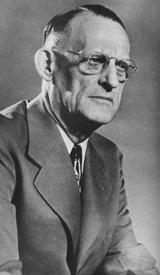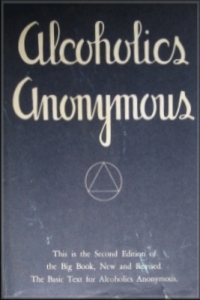
Alcoholics Anonymous (AA) is a global peer-led mutual aid fellowship begun in the United States dedicated to abstinence-based recovery from alcoholism through its spiritually inclined twelve-step program. AA's twelve traditions, besides stressing anonymity, establish it as non-professional, unafiliated, non-denominational and apolitical with a public relations policy stressing attraction rather than promotion. In 2020 AA estimated a worldwide membership of over two million, with 75% of those in the US and Canada.
Twelve-step programs are international mutual aid programs supporting recovery from substance addictions, behavioral addictions and compulsions. Developed in the 1930s, the first twelve-step program, Alcoholics Anonymous (AA), founded by Bill Wilson and Bob Smith, aided its membership to overcome alcoholism. Since that time dozens of other organizations have been derived from AA's approach to address problems as varied as drug addiction, compulsive gambling, sex, and overeating. All twelve-step programs utilize a version of AA's suggested twelve steps first published in the 1939 book Alcoholics Anonymous: The Story of How More Than One Hundred Men Have Recovered from Alcoholism.

Robert Holbrook Smith, also known as Dr. Bob, was an American physician and surgeon who founded Alcoholics Anonymous with Bill Wilson.

William Griffith Wilson, also known as Bill Wilson or Bill W., was the co-founder of Alcoholics Anonymous (AA).
The Twelve Traditions of twelve-step programs provide guidelines for relationships between the twelve-step groups, members, other groups, the global fellowship, and society at large. Questions of finance, public relations, donations, and purpose are addressed in the traditions. They were originally written by Bill Wilson after the founding of the first twelve-step group, Alcoholics Anonymous (AA).
The Oxford Group was a Christian organization founded by the American Lutheran minister Frank Buchman in 1921. Buchman believed that fear and selfishness were the root of all problems. Further, Buchman believed that the solution to living with fear and selfishness was to "surrender one's life over to God's plan".

Cocaine Anonymous (CA) is a twelve-step program formed in 1982 for people who seek recovery from drug addiction. It is patterned very closely after Alcoholics Anonymous (AA), although the two groups are unaffiliated. While many CA members have been addicted to cocaine, crack, speed or similar substances, CA accepts all who desire freedom from "cocaine and all other mind-altering substances" as members.
Higher Power is a term used in Alcoholics Anonymous (AA) and other twelve-step programs. The same groups use the phrases "a power greater than ourselves" and "God of our understanding" synonymously. The term is intentionally vague because the program is not tied to a particular religion or spiritual tradition; members may use it to refer to any supreme being or deity, another conception of God, or even non-supernatural things such as the twelve-step program itself.

Neurotics Anonymous (N/A), founded in 1964, is a twelve-step program for recovery from mental and emotional illness. To avoid confusion with Narcotics Anonymous (NA), Neurotics Anonymous is abbreviated N/A or NAIL.
Al-Anon Family Groups, founded in 1951, is an international mutual aid organization for people who have been impacted by another person's alcoholism. In the organization's own words, Al-Anon is a "worldwide fellowship that offers a program of recovery for the families and friends of alcoholics, whether or not the alcoholic recognizes the existence of a drinking problem or seeks help." Alateen "is part of the Al-Anon fellowship designed for the younger relatives and friends of alcoholics through the teen years".

Rowland Hazard III was an American businessman and member of a prominent Rhode Island family involved in the foundation and executive leadership of a number of well-known companies. He is also known as the "Rowland H." who figured in the events leading to the formation of Alcoholics Anonymous.

Alcoholics Anonymous (AA) is a global fellowship founded in 1935 by Bill Wilson and Robert Smith, and has since grown to be worldwide
Workaholics Anonymous (WA) is a twelve-step program founded circa 1983 for people identifying themselves as "powerless over compulsive work, worry, or activity" including, but not limited to, workaholics–including overworkers and those who suffer from unmanageable procrastination or work aversion. Anybody with a desire to stop working compulsively is welcome at a WA meeting. Unmanageability can include compulsive work in housework, hobbies, fitness, or volunteering as well as in paid work. Anyone with a problematic relationship with work is welcomed. Workaholics Anonymous is considered an effective program for those who need its help.
Charles Barnes Towns (1862–1947) conducted experimentation with cures for alcoholism and drug addiction, and helped draft drug control legislation in the United States during the early 20th century.

Alcoholics Anonymous: The Story of How More Than One Hundred Men Have Recovered from Alcoholism is a 1939 basic text, describing how to seek recovery from alcoholism. Written by William G. "Bill W." Wilson, one of the founders of Alcoholics Anonymous, and many of the first 100 members of the group, the composition process was collaborative, with drafts of the book being sent back and forth between Bill W.'s group in New York and Robert Holbrook Smith, the other AA founder, in Akron, Ohio. It is the predecessor of the seminal "twelve-step method" widely used to treat many addictions, from alcoholism, heroin addiction and marijuana addiction to overeating, sex addiction and gambling addiction, with a strong spiritual and social emphasis. It is one of the best-selling books of all time, having sold 30 million copies. In 2011, Time magazine placed the book on its list of the 100 best and most influential books written in English since 1923, the year in which the magazine was first published. In 2012, the Library of Congress designated it as one of 88 "Books that Shaped America."
Richard Rogers Peabody was an American psychotherapist who specialized in alcoholism.
Adult Children of Alcoholics founded circa 1973 is a fellowship of people who desire to recover from the effects of growing up in an alcoholic or otherwise dysfunctional family. ACA membership has few formal requirements. ACA does not accept any outside contributions and is supported entirely by donations from its members. The organization is not related to any particular religion and has no political affiliation. Tony A. was among its co-founders and is the author of The Laundry List, 12 steps for adult children of alcoholics, The Problem, which are all published in his book, The Laundry List: The ACOA Experience
Underearners Anonymous (UA) is a twelve-step program founded in 2005 for men and women who have come together to overcome what they call "underearning". Underearning is not just the inability to provide for oneself monetarily including the inability to provide for one's needs presently and in the future but also the general inability to express one's capabilities and competencies. The underlying premise of Underearners Anonymous is that underearning is a kind of mental disorder regarding the use of time, rather like the alcoholic's self-destructive compulsion to drink to excess.

Twelve Steps and Twelve Traditions is a 1953 book, which explains the 24 basic principles of Alcoholics Anonymous and their application. The book dedicates a chapter to each step and each tradition, providing a detailed interpretation of these principles for personal recovery and the organization of the group. Bill W. began work on this project in early 1952. By 1957, 50,000 copies were in circulation.

Henrietta McBrayer Buckler Seiberling was a member of a Christian fellowship group named the Oxford Group. Seiberling is well-known for connecting the two men who would found Alcoholics Anonymous.








